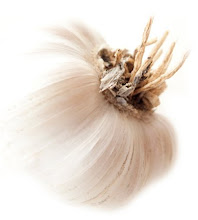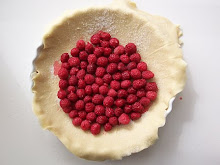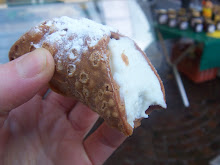
Monday, 28 March 2011
Spring break

Saturday, 19 March 2011
Poppy seed cupcakes with toasted almonds & chocolate fudge

Purim is here, the one holiday of the year dress up and intoxication are considered as 'tradition'. Traditional purim food is all about sugar and dough and can be categorized to 2 main schools of pastry: the east European variety consists mainly of either shortbread or sweet yeast pastry filled with poppy seeds or dried fruit (prunes or dates, ie what was available during the cold European winters), while the Mediterranean pastries consist of different versions of deep fried dough drenched in sugar syrup.
Following visits to an Iraqi and Tripolitanese pastry shops in the week leading to Purim, I’ve had my share of deep fried pastries and hydrogenated oil for the near future and so I decided to play around, baking poppy seeds.
Poppy seeds have quite a troubled reputation, and in a way, rightfully so. You see, if poppy seeds are ground they begin to taste bitter and stale within hours, and since this is how they’re sold in supermarkets, people have grown to assume this is what they taste like. Nasty.
Truth is, freshly ground poppy seeds are nutty and sweet and nothing like the nasty pre-ground version. I baked these cupcakes for Sabrina's Purim/Birthday party. These are a combination between a poppy seed loaf cake (turned cupcakes) and an ice cream flavor close to my heart, essentially apoppy seed & almond tart thrown inside an ice cream maker. heavenly.
If there’s one thing that will determine the success of these cupcakes it’s grinding the poppy seeds right before they’re ready to be used. The longer time passes between grinding and baking the sweet, nutty poppy seeds will begin to taste bitter and stale and generally awful. They can be ground using a spice or coffee grinder. Alternatively, buy them in a spice shop, ground to order, then rush home and keep them sealed in the freezer.
If you want to read more about Purim and its pastries, this is a link to an article published earlier this week on the NYTimes.

Poppy seed cupcakes
with toasted almonds & chocolate fudge
Adapted heavily from ‘Orna & Ella’
Makes approx 15 cupcakes
125g poppy seeds, freshly ground
2 heaped tbs all-purpose flour
3 heaped tbs breadcrumbs
100g butter, room temperature
1/3 cup sugar
4 eggs yolks
¼ tsp vanilla extract
1/8 almond extract
4 egg whites
2 tbs sugar
A pinch of salt
Chocolate fudge topping
100g dark chocolate (min. 70% cocoa solids), chopped
25g golden syrup
25g butter
A handful of slivered almonds, sliced and toasted
- Preheat the oven to 170C. Butter and flour a cupcake tin and set aside.
- Place a tin large enough to accommodate the cupcake tin and fill it with water to a height of 2cm.
- In a small bowl, combine the ground poppy seeds, flour and breadcrumbs. Set aside
- Using an electric hand whisk, cream the butter and sugar until light and fluffy.
- Add the eggs, one at a time, whisking well after each addition.
- Add the vanilla and almond extract and whisk until incorporated.
- Gradually add the poppy seed-flour mixture, whisking it on the lowest setting until almost combined. use a spatula for the last few turns, until combined.
- In a clean bowl, use the highest setting on your electric hand whisk to whisk the egg whites, salt and sugar to stiff peaks.
- Fold 1/3 of the egg whites into the poppy seed mixture. Add the remaining egg whites and fold until incorporated.
- Spoon the mixture into the tin and bake in the oven for 20 minutes or until a toothpick inserted in to the middle of a cupcake comes out clean.
- Remove from the oven. Once cool enough to handle transfer to a rack to cool completely.
- While the cupcakes are cooling away prepare the chocolate ganache: Place the chopped chocolate in a heatproof bowl and over a saucepan of simmering water (a double-boiler), until the chocolate has melted (make sure the bottom of the bowl isn’t touching the water).
- Add the butter and golden syrup and stir until smooth.
- Spread the fudge over the cupcakes and decorate with toasted almonds. Allow it to cool.
Saturday, 12 March 2011
Fresh Garlic confit

Its almost mid march. Thats a spit away from a fully blown spring. When did that happen?
This time of the year goes by so quickly, but for now the almond trees are in full bloom and, like lanterns showing the way, I see them scattered along the highway leading to Jerusalem.
At the market, alongside tomatoes, melons and grapes that are oddly offered and on display, the stalls are bursting with all sorts of green: there's spinach, peas and string beans, artichokes, fava, and an elusive favorite, the green garlic.
Most of the year one can mostly get a hold of dry imported garlic from China, but around this time of year the fragrant green version pops up here and there and worth watching out for.
The other day I was out market and bought a bunch. The garlic is sold with the thick stem and leaves still attached and this serves 2 needs; a) it looks good, all fresh and straight from the ground, but b) when put on the scale, the garlic weighs more, ending with the customer paying more for less. gotta love it. When I suggested to the vendor to do it the other way around I was met with a sniggering laugh. I must have been kidding. I returned home, poorer yet richer, with tagged by a garlicky cloud that followed me all the way back home.
The layers that dry up and flake away are fresh and fragrant. These I like to chop into a salad or soup. Using them up makes way for bright white garlic cloves that ooze a pungent freshness. There has got to be a way to hold on to these for longer. There is. Green garlic confit. The closest thing to stopping time.
There isn’t a recipe as such, the thing to do is buy quite a few, and prepare enough confit to last you for some time.

Garlic confit
Green garlic, separated to cloves (you can cook with the fresh leaves, so don’t throw them away)
Olive oil
Place the garlic cloves in a saucepan so that they reach halfway of its hieight.
Cover with plenty of olive oil and cook over medium- low heat.
The temperature shouldn’t be too high and small bubbles will gently rise to the surface but it mustn’t boil or simmer. We want the garlic to cook in the oil, not deep-fry it.
Cook the garlic for about 30 minutes or until the cloves softened. Set aside and allow to cool.
Transfer the garlic and the now aromatic olive oil to a clean jar and store in the fridge.
Remember to use only clean utensils to scoop the cloves out or drizzle the oil.
That’s it. A little work will take you along way. These are wonderful on toast with anchovy and rubbed tomato, as pasta dressing, with olive oil, salt and pepper, or minced and rubbed over flat dough, sprinkled with crushed salt and rosemary needles for a garlicky pizza.
The olive oil is the cherry on top, having been infused with the garlic. For immediate elevation use it to fry your omelettes, baked goods or anything else you use olive oil for.
Saturday, 5 March 2011
Spelt and lima bean mujadara

I grew up in Jerusalem but left as soon as I could. Its been a love-hate relationship ever since. For years it was strictly an ‘in & out’ arrangement, where I would come to my parents’ house and head back as soon as I could to modern civilization. Anything more was too much to handle.
I’ve been spending more time in the city recently for food purposes and I find am making peace with it through my stomach.
Once it stopped being a threat, attempting to swallow me back and suffocating me inside its dense stone walls I allowed myself to rediscover it, its timelessness quality and that je ne sais qua quality that gets people to lose their mind and fight over it, as if it could be won and be owned.
The heavy, overbearing seriousness with which reality is grasped by is refreshing, be it for a few hours at a time and it is nothing short of a trip abroad less then an hour away, as well as back in time.
Once again the power of food proves itself as a peacemaker and a softener of the heart.
I recently made mujadara, a dish that could probably spark yet another right of ownership war, as is the case with most dishes local to the region. It usually consists of lentils and either rice or bulgur, but I decided too give it a facelift and make it my own. I replaced the grains with spelt kernels, the lentils with lima beans and the yogurt topping for sheep’s milk feta cheese, leaving the fried onions (aka the best bit), untouched. With carbs, proteins, cheese, aromatic herbs, a satisfying crunch and a bouncing bite all in attendance and at their sharpest the only thing missing is dessert.

Spelt and lima bean mujadara
Serves 2
Ingredients
Olive oil
1 cup whole spelt kernels
1 cup lime beans, soaked in water overnight and cooked in boiling water until softened, about 35 minutes
1 red onion, chopped finely
1 sprig of rosemary, needles separated
½ lemon, freshly squeezed
Freshly ground pepper, to taste
Sea salt, freshly ground, to taste
Serve with
1-2 tbs sesame seeds, lightly roasted in a dry pan, then ground in a mortar & pestle
A handful of peanuts, lightly roasted and chopped
Sheep’s milk feta cheese, crumbled
- Place the spelt kernels in a medium sized saucepan, pour 1 ½ cups of water and bring to a boil over medium- high heat. When the water is simmering, cover and cook over a low heat for 45 minutes. Remove from the heat and set the saucepan aside, still covered, for about 5 minutes. Use a spatula to fluff the spelt.
- While the spelt is cooking heat a little olive oil in a frying pan. add the chopped onion and fry over a medium- low heat until fried and crispy, but not charred.
- In a large bowl, add the cooked spelt lima beans and the fried onion. Add the rosemary and season with salt, pepper, olive oil and lemon juice. Taste and adjust seasoning, if needed.
- Transfer to a serving plate and serve warm, sprinkled with ground sesame seeds, chopped peanuts and crumbled feta cheese.













